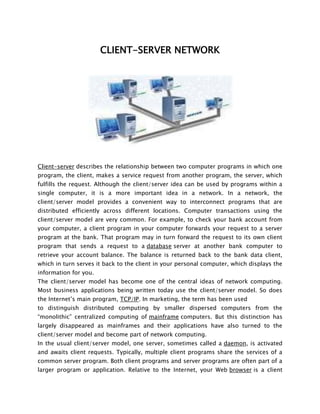
Client_Server_Network.pdf
- 1. CLIENT-SERVER NETWORK Client-server describes the relationship between two computer programs in which one program, the client, makes a service request from another program, the server, which fulfills the request. Although the client/server idea can be used by programs within a single computer, it is a more important idea in a network. In a network, the client/server model provides a convenient way to interconnect programs that are distributed efficiently across different locations. Computer transactions using the client/server model are very common. For example, to check your bank account from your computer, a client program in your computer forwards your request to a server program at the bank. That program may in turn forward the request to its own client program that sends a request to a database server at another bank computer to retrieve your account balance. The balance is returned back to the bank data client, which in turn serves it back to the client in your personal computer, which displays the information for you. The client/server model has become one of the central ideas of network computing. Most business applications being written today use the client/server model. So does the Internet’s main program, TCP/IP. In marketing, the term has been used to distinguish distributed computing by smaller dispersed computers from the “monolithic” centralized computing of mainframe computers. But this distinction has largely disappeared as mainframes and their applications have also turned to the client/server model and become part of network computing. In the usual client/server model, one server, sometimes called a daemon, is activated and awaits client requests. Typically, multiple client programs share the services of a common server program. Both client programs and server programs are often part of a larger program or application. Relative to the Internet, your Web browser is a client
- 2. program that requests services (the sending of Web pages or files) from a Web server (which technically is called a Hypertext Transport Protocol or HTTP server) in another computer somewhere on the Internet. Similarly, your computer with TCP/IP installed allows you to make client requests for files from File Transfer Protocol (FTP) servers in other computers on the Internet. Other program relationship models included master/slave, with one program being in charge of all other programs, and peer-to-peer, with either of two programs able to initiate a transaction. Client-Server Applications The client-server model distinguishes between applications as well as devices. Network clients make requests to a server by sending messages, and servers respond to their clients by acting on each request and returning results. One server generally supports numerous clients, and multiple servers can be networked together in a pool to handle the increased processing load as the number of clients grows. A client computer and a server computer are usually two separate devices, each customized for their designed purpose. For example, a Web client works best with a large screen display, while a Web server does not need any display at all and can be located anywhere in the world. However, in some cases a given device can function both as a client and a server for the same application. Likewise, a device that is a server for one application can simultaneously act as a client to other servers, for different applications. [Some of the most popular applications on the Internet follow the client-server model including email, FTP and Web services. Each of these clients features a user interface (either graphic- or text-based) and a client application that allows the user to connect to servers. In the case of email and FTP, users enter a computer name {or sometimes an IP address} into the interface to set up connections to the server. Local Client-Server Networks Many home networks utilize client-server systems without even realizing it. Broadband routers, for example, contain DHCP servers that provide IP addresses to the home computers (DHCP clients). Other types of network servers found in home include print servers andbackup servers.
- 3. Client-Server vs Peer-to-Peer and Other Models The client-server model was originally developed to allow more users to share access to database applications. Compared to the mainframe approach, client-server offers improved scalability because connections can be made as needed rather than being fixed. The client-server model also supports modular applications that can make the job of creating software easier. In so-called “two-tier” and “three-tier” types of client- server systems, software applications are separated into modular pieces, and each piece is installed on clients or servers specialized for that subsystem. Client-server is just one approach to managing network applications The primary alternative,peer-to-peer networking, models all devices as having equivalent capability rather than specialized client or server roles. Compared to client-server, peer to peer networks offer some advantages such as more flexibility in growing the system to handle large number of clients. Client-server networks generally offer advantages in keeping data secure. Source: http://computrnetworking.wordpress.com/2012/02/20/client-server- network/